Archive for category April 2016
Report Highlights the Need for a More Diverse Demographics in the Region
Posted by admin in April 2016 on April 10, 2016
By Kollengode S Venkataraman
e-mail: Â ThePatrika@aol.com
Do you know that the work force in southwestern Pennsylvania (Allegheny County, including the City of Pittsburgh and the six surrounding counties) is the least demographically diverse compared to many other benchmark metropolitan areas in the US? That is what Pittsburgh Today (www.pittsburghtoday.org), an initiative of the Regional Indicator Program (Mr. Douglas Heuck, Program Director) finds in its recent report. The initiative is hosted by the University of Pittsburgh’s Center for Social and Urban Research. Its mission is “Comparing our region to other areas of the country… [on] how we measure up, and what our strengths and weaknesses are…†They attempt to provide a statistical picture of the region “to stimulate a discussion of where we are and where we hope to go.â€
The second report, The Pittsburgh Regional Survey under the aegis of Vibrant Pittsburgh (www.vibrantpittsburgh.org) was released on January 13. Mr. Heuck presented the key findings. Vibrant Pittsburgh’s mission, with support from Pittsburgh-based business executives, elected officials, and charitable organizations, is to promote diversity in work places. Melanie Harrington, the CEO of Vibrant Pittsburgh, led the event releasing the survey.Recently they published two reports, 2015 Pittsburgh Today and Tomorrow and Pittsburgh Regional Survey (2016). These reports are available on line. A key finding in the first report is troubling and worth reproducing: “The share of jobs held by African Americans, Asian Americans, and Hispanic workers in southwestern Pennsylvania is so small that it ranks dead last among 15 regions benchmarked…â€
The presence of Allegheny County Chief Executive Rich Fitzgerald’s and Pittsburgh Mayor Bill Peduto at the event gave additional gravitas. Their participation on a wintry day, with single-digit temperatures and snow all around, highlighted how seriously these two key elected leaders of our region look at the lack of work-place diversity here.
In his opening remarks Fitzgerald acknowledged that our region is the least diverse metro area in the nation, and explained why addressing it is important to the city, county and the region. As Mayor Peduto said in his comments towards the end, Nashville, TN, Louisville, KY, and Cincinnati and Columbus in Ohio have more diverse demographics. The mayor poignantly pointed out that a few decades ago, the Duquesne Club, the exclusive meeting place for corporate executives in town, did not allow Jews to be members, and women were not allowed to be full members. We would not have grown to where we are today, he said, if we had not changed.
Fitzgerald identified two welcome trends in the 2015 Pittsburgh Today and Tomorrow report: young people growing up here prefer to stay here, and educated young people are moving into our region from outside with jobs. After all, Pittsburgh has been identified as one of the More Livable Cities with its excellent public and private schools for children, world-renowned universities, a top-notch healthcare system, nationally ranked sports teams, an excellent airport, museums, theaters, a world class symphony, ballet… … Still, many outsiders’ continue to associate coal and steel with our region, even though today steel and coal are only a very small part of our region’s economy.
If you wonder why workplace diversity is important, consider this: the demography of the US has been changing as shown in the chart below (Ref: The U.S. Foreign-Born Population: Trends and Selected Characteristics, by William A. Kandel, CRS Report for Congress, 2011 (http://fas.org/sgp/crs/misc/R41592.pdf)
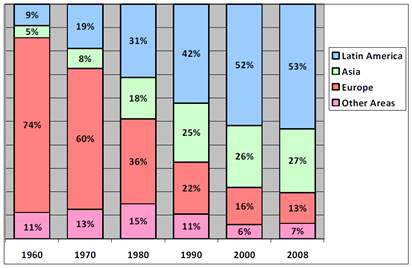
The % of Foreign-Born in the US since 1960.
We can project this trend into the future and see how the mix of US population will be in the decades ahead. The America our children and grandchildren will see will be very, very different demographically. This trend will irreversibly change every aspect of life in the US.
Besides, the population growth in our region between 2000 and 2010 is almost zero compared to, say Charlotte, NC (7% growth), Denver (8.8%), Columbus, OH (4.9%), Indianapolis, IN (4.4%), and Louisville, KY (2.8%). Generally, metro areas that are growing are also more diverse demographically.
In the globalized world today, a diverse population is necessary for our region’s vitality and growth. When US corporations and multinationals based in Europe and Asia want to open offices here, or want to move their headquarters here, one key factor for their evaluation is how demographically diverse the place is to make their current employees move here, or to hire new employees from outside.
Among the many questions the Pittsburgh Regional Survey (2016) asked its respondents were these:
How committed do you think your employer is
- i) to recruiting employees from racial and ethnic minority groups?
- ii) to promoting employees from racial and ethnic minority groups?
Do you agree that the Pittsburgh region welcomes racially/ethnically diverse people?
How racially and ethnically diverse is your workplace?
Do you agree there is value in having a diverse workforce?
The survey also asked this thoughtful question in their questionnaire: How often have you invited someone of another racial or ethnic background to your home?Â
With so many subgroups within the Indian Diaspora here, we need to ask ourselves: How often have you had some serious conversation in your home or in a restaurant with Indians of other linguistic and regional background? Sometimes one wonders whether we are living in our own echo chambers unwilling to learn from others outside our comfort zone.
Laws Changing the US Demographics
(Source: Abraham Mosisa, an economist in the Division of Labor Force Statistics, Bureau of Labor Statistics, in the Monthly Labor Review, May 2002 and http://www.bls.gov/opub/mlr/2002/05/art1full.pdf).
In the 18th and 19th centuries (the early days of the Republic), immigrants reached the Eastern Seaboard mostly from Northern Europe (England, Germany, France) and Africa (slave trade). In the 19th century, Irish immigrants came in large numbers to escape the famous Potato Famine.
Simultaneously, starting in the mid-19th century, Chinese contract labors were brought to the West Coast to work in the gold mine and also to lay the Transcontinental Railroad. You can see in Hollywood Westerns Chinese immigrants barely speaking English operating the laundromats, and sweating it out laying the railroads. The influx of Chinese laborers was stopped by the Chinese Exclusion Act in 1882.
Starting from the 1900s new immigrants from Europe came increasingly from Southern and Eastern Europe (the Italians, the Greeks, the Poles, the Slavs …), mostly Catholic, poorly educated, and with little familiarity with English, both in terms of language and culture.
The Immigration Act of 1917 restricted European immigration and the 1921 Emergency Quota Act applied immigration quota on the basis of nationality and the country of origin. This quota-based act was reaffirmed in the Immigration and Nationality Act of 1952, which remained in force with minor changes till 1965.
The Immigration and Nationality Act of 1965 is a great bench mark in US history. It did away with quota-based immigration that took into account race, national origin, and ancestry. Between 1960 and 2000, the proportion of the foreign-born population that had come from Europe dropped from 74.5 percent to 15.3 percent, while the proportion coming from Latin America increased from 9.3 percent to 51 percent.â€Â See the chart on Page 4. The Nationality Act of 1965 is the reason most Indian-Americans are here as immigrants, naturalized and natural citizens. By country-of-birth in the population among the foreign-born, Europe is way below. Basis: 2010 Census. See the plot below.
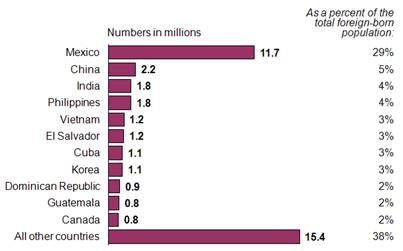
Population of Foreign-Born in the US (US Census 2010 data)
            ♦♦♦♦
An Unusual Opportunity to Help to Girls’ Education Among the Working Poor in India
Posted by admin in April 2016 on April 10, 2016
By Nandini Mandal, Nandanik Dance School
e-mail: nandini@nandanik.com Â
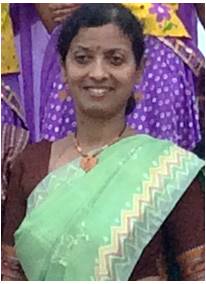 Santosh Gurlahosur, a young IT professional, approached me last summer with a request: “Ma’am, would you be able to choreograph for a music video emphasizing the importation of sanitation in village schools — especially for the girl child?â€
Santosh Gurlahosur, a young IT professional, approached me last summer with a request: “Ma’am, would you be able to choreograph for a music video emphasizing the importation of sanitation in village schools — especially for the girl child?â€
Knowing that one of the main reasons for high dropout rates of post-puberty girls in schools in rural India is the lack of sanitation, I instantly said, “Of course, I would love to.†Santosh smiled a hesitantly, “Really Ma’am? Thank you, no one was convinced when I approached others.â€
He was planning to shoot a video presentation with other footage with a song along with a public message for use in India or elsewhere. After the initial planning, we—our dance school working with Teen Taal, Inc. —opted for an outdoor shoot. What else could be a better place than the Point, Pittsburgh’s very own Triveni Sangam?
It was a warm sunny July morning when dancers of our Nandanik Dance Troupe arrived at Point State Park. As we danced at different
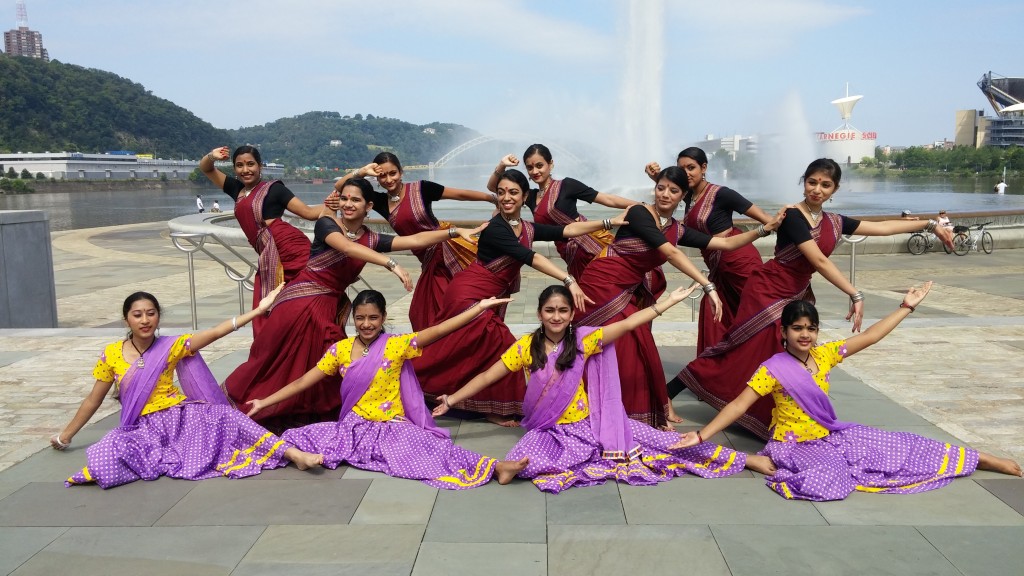
L to R — Front row : Mythri Sundar, Antara Cleetus, Ashwini Walavalkar, and Janhavi Gan-gisetti. Second row: Kumudini Venkata, Jahnavee Mittal, Sana Mitra, and Sai Bhatte. Third row: Keerthana Lanka, Manasi Jadhav, Roosha Mandal, and Madhumita Mahes.
spots at the Point, the sun soared higher, the mercury climbing to the 90s by 11:00 a.m. It became increasingly challenging for the dancers to look at the camera, or keep dancing without taking frequent breaks for drinking water. But they never complained. Our audience — they were bystanders, bikers, tourists, joggers, and people from all walks of life – were enthralled. They all had come to the fountain to enjoy a summer morning when they saw the girls taking their positions. They stopped and cheered after the dance was over. Many came up to ask what it was all about.
The lyrics by Santosh portray the regret of a girl child in India who is not able to go to school because of the lack of basic facilities such as toilets. The girl loves to study and wants to play with her friends in the school, but she is not able to do so. This song is sung by Indian Idol winner Anjana Padmanabhan and composed by an upcoming music director in India Nobin Paul of Bengaluru. The video was filmed by David Bernabo, a very talented film maker and artist from Pittsburgh.
The song also brings up a more serious question: When so much construction is going on all around India, why are toilets for girls in schools for the working poor not a priority?
The girls in my dance school felt very strongly about this and were happy to contribute to this noble endeavor through their dance. Many of them have seen the difficulties traveling in India because of the lack of sanitation facilities for women.
I was very touched by Santosh Gurlahosur, the motivated young man, and his young group of volunteers who are trying quietly and selflessly to help in the cause of girls’ education in rural India.  ♦
Exhibition on Poems and Paintings
Posted by admin in April 2016 on April 10, 2016
By Premlata VenkataramanÂ
e-mail: Â ThePatrika@aol.comÂ
We have seen paintings inspired by mythology and history: Da Vinci’s Last Supper, John Trumbull’s Declaration of Independence  and Raja Ravi Varma’s paintings on events from Ramayana and Mahabharata, and Gandhi’s Salt March to Dandi. And add to that the famous Geetopadesham scene by countless artists.
In this tradition, the Post-Gazette inaugurated Verse Envisioned, an art exhibition at the Panza Gallery in Millvale featuring over twenty paintings inspired by the works of contemporary Pittsburgh-based poets. The cornucopia of poems spanned a wide range of themes.
On Saturday, January 16, the inaugural day of the exhibition, artists of Pittsburgh and their patrons were in full attendance, notwithstanding the cold, wintry day. The exhibition ran from January 16 to February 27. Seeing the two art forms side by side complementing and enhancing each other, was a unique experience.

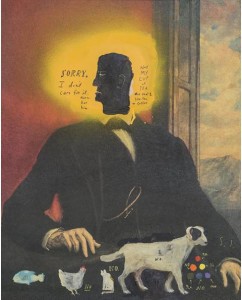 The exhibition was made a reality under the leadership of Greg Victor, the Op-Ed editor of the Post-Gazette, and Rachel Klipa, an independent curator and the Manager of Community Engagement at the Office of Public Art in Pittsburgh.
The exhibition was made a reality under the leadership of Greg Victor, the Op-Ed editor of the Post-Gazette, and Rachel Klipa, an independent curator and the Manager of Community Engagement at the Office of Public Art in Pittsburgh.
Welcoming the large crowd at the exhibition, Greg Victor credited Sam Hazo, Poet Laureate of Pennsylvania, who, in 1993 suggested to the Post-Gazette editors to include poetry as a feature in the newspaper. It is now featured on Saturdays. If we did not know the background, it would have been difficult to say whether the poem inspired the painting or the other way around.
Maya Weiss, one of the featured poets, read her poem titled The Man Who Didn’t Like Anything. She is a 10th grader at Shadyside Academy. It was a humorous and somewhat cynical poem juxtaposed with a painting by Stacy Innerst.  See above.
David Joseph Kutcher’s Civics was an emotional and poignant poem in which the poet recollects the supreme sacrifice of his father in WW II as the reason he goes to vote in every election. Alan Byrne’s painting showed a man in front of the voting machine with a group of soldiers (his forebears) behind him looking on. See below:
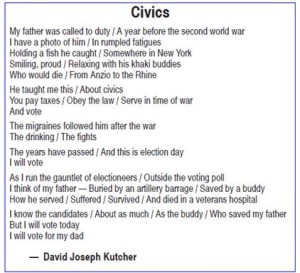
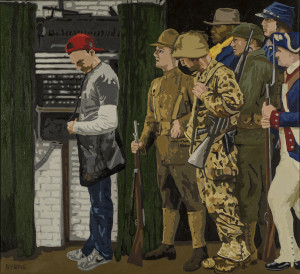
Lori Jakiela’s poem on aging and dying, replayed between a woman with her aged father and her young daughter, echoed a sentiment that many of the sandwich generation are feeling.
Bringing together two very different art forms and harmonizing the themes require lots of creativity from everyone involved. So making the exhibition a reality was a treat to lovers of poetry and painting during a chilly day in January in Pittsburgh.
We thank the efforts of the editorial staff at the Post-Gazette, and the poets, painters, curators and gallery  owners for making this happen.
The book containing the paintings and the poems featured in the Post- Gazette is available online at www.store.post-gazette.com.
Note: We thank Mr. Mark Panza of the Panza Gallery in Millvale where the exhibition was held for all the pictures in this story.  ♦
Obituary:Â Dr. Indravadhan Pandit (1937- January 20, 2016)
Posted by admin in April 2016 on April 10, 2016
Dr. Indravadhan Pandit, a long-time resident of our area and a cardiologist, passed away on Wednesday, January 20, 2016. The cause of his death was complications from pancreatic cancer for which there is no cure.
 Dr. Pandit grew up in Visnagar, Mehsana district, in the northeast part of Gujarat. Earning his medical degree (MBBS) from the Baroda Medical College in 1966, he came to the United States with his wife Devyani, also a physician. After short stays in Detroit, Boston and Cleveland, he made Pittsburgh his permanent home, starting his medical practice.
Dr. Pandit grew up in Visnagar, Mehsana district, in the northeast part of Gujarat. Earning his medical degree (MBBS) from the Baroda Medical College in 1966, he came to the United States with his wife Devyani, also a physician. After short stays in Detroit, Boston and Cleveland, he made Pittsburgh his permanent home, starting his medical practice.
He was an interventional cardiologist for over three decades at UPMC Shadyside Hospital and its director of the catheterization laboratory for several years. He was a fellow of the American College of Cardiology and a member of the American Medical Association. He was also with the Pennsylvania Medical Society, where he was active in establishing need-based scholarships for medical students.
As a philanthropist, Dr. Pandit lived and breathed working for charities. As chairman of the AAPI (American Association of Physicians of Indian Origin) Foundation, he put his heart and soul into visiting clinics from Punjab to Tamil Nadu serving thousands of poor patients at no or minimal cost. He passionately raised funds in Pittsburgh for almost twenty years for this cause. In 2002, the AAPI honored Dr. Pandit with its Most Outstanding and Dedicated Service Award.
Dr. Pandit’s interest went beyond his professional activities. He was a pillar of the Indian community in our area. He was a founding member of the Hindu Jain Temple, where he served as Chairman of the Board of Trustees, and also its Endowment Fund. Dr. Pandit, working closely with other volunteers at the temple, raised large sums of money for the maintenance and restoration of the temple. The temple honored him and his wife Dr. Devyani with a Lifetime Service Award.
Dr. Pandit was a member of TAPI (Tri State Association of Physicians of Indian Origin), the treasurer of the US-India Forum, and the secretary-treasurer of the Encyclopedia of Hinduism. If there was an India cause in town, he was engaged in it. He was actively involved with the Indian Nationality Room project in the Cathedral of Learning at Pitt. He was also a benefactor of the Carnegie Museums and many other charities. Even in his retirement, he volunteered at a food packing facility near Kennywood that delivered food to the homeless.
He was a voracious reader of Indian literature and eastern and western philosophies. His other pastimes were golf, tennis, music and dance.
A principled man, Dr. Pandit would not compromise with anyone for the right cause. I was once sharing a room with Indravadhan at the AAPI Governing Body gathering. Seeing that I was active in a political action committee, he told me, “Krishan, if you want to work in a charitable foundation, it is pure like Ganga in Rishikesh, serving the poor and needy; otherwise politics is dirty water.†I could not agree with him more.
His friend Jitu Desai recalls, “Indravadhan was a giving and forgiving man. Anyone asked him for charity, he always responded generously.â€
He endured the treatment (including chemotherapy) for pancreatic cancer with great stoicism and grit. When we went to see him, he was positive, witty and ready to fight till the very end.
He leaves behind Devyani, his life partner of 40-plus years; his two daughters,Amy and Neha; five grandkids, Anand, Asher, Ariya, Maneklal and Maria; his sons-in-law, Ashis Tayal and Daniel Gerhardy; and a number of friends in the medical fraternity and the Indian community.
Dr. Pandit’s funeral services were held at the Beinhauer Funeral Home with his son-in-law Ashis Tayal performing the Hindu cremation rites led by Pandits Shri Suresh Chandra Joshi and Shri Vinod Pandey of the Hindu Jain Temple.  — By Krishan Aggarwal, Coraopolis, PA   ♦
Bhartrhari’s Nine Fears of Mankind
Posted by admin in April 2016 on April 10, 2016
By K S Venkataraman (e-mail: ThePatrika@aol.com) and
Arun Jatkar (e-mail: AJMarathi@yahoo.com)
Bhartrhari is a celebrated Sanskrit poet of India belonging to the 5th century during the Gupta’s period. He is the author of the famous Tri-Satakam (literally, The Three-Hundreds), on three topics ─ Vairaagyam (Dispassion), Neeti (Good Conduct), and Shrngaaram (Sensuality) ─ with one hundred verses on each. Decades ago, when we read his sensuous verses on Shrngaaram, we wondered how Bhartrhari could also write profoundly on Vairaagyam (Dispassion). We found that Bhartrhari is not unique here. TiruvaLLuvar (वळà¥à¤³à¥à¤µà¤°à¥ not वलà¥à¤²à¥à¤µà¤°à¥), the author of the famous 2000-year old Tamil literary work called TirukkuraL with 1330 couplets, wrote along similar lines. For most mortals, the transition from Sensuality to Dispassion is a natural and healthy one, coming from one’s mental maturity and also because of age-related drop in testosterone in men and estrogen in women.
In any case, here is one verse by Bhartrhari from the Vairaagya Satakam on the nine fears of mankind, first in the Devanagari script, and then in a non-literary, but factual translation:
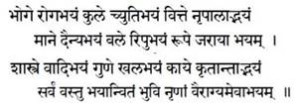
In gratification of sensual pleasures, the fear of ailments;
In noble pedigree, the fear of disgrace; Â In wealth, the fear of kings;
In status, the fear of hardship; Â In strength, the fear of enemies;
In beauty, the fear of decay; Â In scholarship, the fear of challengers;
In virtues, the fear of slander; Â Â In the body, the fear of death.
In this world, everything for mankind is filled with fear.Â
Dispassion alone gives freedom from fear.
On first reading, the verse is straightforward and rather mundane. However, on many levels, the messages conveyed are profound for their timelessness, given that the verse is 1500 years old.
On Indulgence: The Sanskrit word bhoga means sensual gratification that needs to be understood in many contexts. There is no need to expand on the most common sensual pleasure. There are other types of sensual gratification. The common one is gluttony — overindulgence in the calorie-packed and unhealthy food and drinks. Even modern medicine emphasizes moderation in these, something Asian cultures have insisted through the millennia. Observing Bhartrhari start his verse with sensual gratifications, we can infer that people overindulged even in his time.
Fear of Kings: It is interesting that in the case of wealth, Bhartrhari talks about the fear of kings, and not thieves and robbers. Today, with elected governments replacing kings of yesteryear, landowners are afraid of land ceilings and ownership through legislation; business people are afraid of governments nationalizing industries and bringing in foreign and domestic competition. Even when these laws are enacted for public good, land and business owners always cry foul for getting a better deal out of the government.
And people with wealth are perpetually anxious of changes in tax and inheritance/estate laws to protect their wealth. This fear is what is forcing them to stash their money — hard-earned or not, well-gotten or ill-gotten — in secret off-shore banks.
Fear of Falling from Grace: This fear is universal. Today we see people from blue-blooded or rich families, religious leaders, celebrities, politicians and others, get arrested for sexual misconduct and financial irregularities. In the US, even prestigious Catholic dioceses carry liability insurance out of fear of lawsuits against errant priests’ misconduct. Several dioceces in the US also filed for financial bankruptcy after losing their moral edge, in the wake of lawsuits involving wide spread pedophilia indulged by Catholic priests that was covered up by church leadership not only in local churches, but also by the bishops of dioceses, prelates, going all the way up to to the Pope in the Vatican.
Fear of Enemies: No kingdom remains strong forever. Towards the end of Mahabharata, Arjuna, the most celebrated warrior, finds himself helpless against the tribesmen who attack and rob the ornaments of the women he was escorting to safety from Dwaraka to Hastinapuram. The mighty Roman Empire collapsed under the brute force of the Barbarians from Northern Europe. Between the 8th and 12th centuries, the mighty Hindu kingdoms of Northern India succumbed to the invading Arab, Turkish and Afghani armies. The Ottoman Empire collapsed at the end of the First World War. The tiny island nation of England spread its reign over five continents and finally shrank back to its original confines. After the Second World War, it seemed like the U.S. would forever remain an unrivalled military power in the world because of the nuclear weapons. But that dream shattered several years afterwards.
So the strong nations of today, the US, France, Germany, Russia, China, and England, spend billions year after year to upgrade their armies and weapon systems out of their fear of enemies, both real and perceived. Even in poorer countries defense budgets gobble up a large portion of the national budget, while their citizens don’t have access to half-decent education and healthcare. The fear of enemies is not confined to military might alone. Economic and technological threat among nations is also real.
Fear of Decay Due to Aging: No one remains handsome or beautiful forever. Time takes its toll wreaking havoc on one’s health and beauty. In earlier days people accepted this as natural. However, advances in science have given hope that beauty can be preserved for a longer span of time. Among women, the fear of fading beauty with aging has spawned a whole new industry — Cosmetic and Reconstructive Surgery — originally developed to treat burn victims and people with severe deformities. In 2014 in the US, 92% of all elective cosmetic procedures were performed on women: One million cosmetic procedures on women under 30 years of age and a whopping 13.8 million on women over 30. (Source: www.plastic surgery.org). Today, the original intent of plastic surgery may account for less than 5% of plastic surgeons’ lucrative business.
Fear of Competition: We all understand the insecurity that professionals, college professors (including tenured ones), lawyers, doctors, artistes, and engineers feel from colleagues perceived to be better than themselves; or when newer technologies make their skills useless. While they profess that competition is good for society at large, as individual professionals they are not philosophical when they see competition threatening their own survival, or demolishing their theories or defunding their pet projects.
In today’s consumer world progress is seen as synonymous with higher per-capita consumption of every commodity. So, people caught in the whirlpool of trying to get ahead of others in the comparative lifestyle today may not agree with Bhartrhari’s advice that Vairaagyam (dispassion) is the antidote for fear. But people standing out of the vortex of consumerism are beginning to say, “Enough.â€
In any case, even those who disagree with Bhartrhari’s antidote to fear will agree that his Nine Fears of Man are as valid today as they were 1500 years ago when he wrote the verse. These fears are still the driving forces controlling not only our individual behavior, but also our collective behavior as societies, corporations and nations.  ♦
On the Association of “British†Scholars
Posted by admin in April 2016 on April 10, 2016
By Kollengode S Venkataraman
E-mail: Â ThePatrika@aol.com
I was watching a YouTube video. The New Age Guru Deepak Chopra was talking in his deep, resonant voice about mind-body nexus, a topic now mainstream in modern medicine. The banner behind in loud colors read Association of British Scholars, New Delhi. I was intrigued by the name of the organization. Then I e-mailed several of my cerebral friends — researchers, physicians, university professors, linguists, and eclectic people with good tastes in music, art, literature — with this request:
“If you find an organization that goes by the name Association of British Scholars, India, what would be your understanding of the organizers and members of that group? Will you please give me your answers in two or three sentences? I assure you that I will keep your response private.â€Â
I only said my friends are cerebral. That does not imply that I am. Here are their responses in the following paragraphs. I am reproducing them verbatim, except in one case, where I have truncated it to save space. Since I assured them I would keep their responses private, I only give the initials of the respondents as my own memory aid so that I know who they are. Here I go:
JK: My initial take on this would be that it represents a group of British scholars who live in India. Or, on second thought, that they are Indians in India who have made Britain the focus of their scholarly endeavors.
SS: To me, it would suggest an India-based chapter of a worldwide group of scholars of British origin.
JL:Â This is a group of historians who have specialized in the field of British Empire and British Raj in India. They are based in India and may include Indians and remnants of the rulers who stayed on in India. Modesty is not their virtue; otherwise the name of the Association would have been Study Group of British Empire and British Raj, India.
BD:Â Looks like a scam.
SS: My first reaction will be that this organization is a group of British “Scholars” who are interested in defending the Raj Period of Indian History. Personally, I would like to hear them and what they stand for.
AJ: On the face of it, a name like “Association of British Scholars, India” would mean to me that it is an organization of scholarly people of British origin, who are residing in India. But, when you look closer, it is odd: 1) A group of true scholars will not call itself “Scholars.”  They may call themselves “Indologists,” “Historians,” “Mathematicians,” “Engineers,” “Physicians,” “Writers,” etc., but wlll shun the epithet “Scholars.â€Â 2) We are led to believe that the British are unlikely to be self-promoters†— don’t know how true it really is. I wonder if this could be a group of Indians who have no humility at all and have never heard or read that humility is the true ornament of knowledge and wisdom, calling themselves “British Scholars.â€Â One is tempted to ask, “British scholars of what branch of intellectual inquiry?â€
PV: My understanding of this is that it is a bunch of scholars from Britain who are based in India. Since the Association is of British Scholars, the comma denotes the further clarification on their location.
HS:Â I can only take a guess. I assume you have talked to Jxxx Myyy, Assistant Professor, History Department at XXX YYY Univ.
SC:Â I would assume that it comprises of Indian people who have had higher education in Britain and are currently residing in India.
RS: It sounds like a group of Brits in India who call themselves scholars.
Now, ABS (Association of British Scholars) is in India with over 24 branches, including Vishakhapatnam, AP, Bhubaneshwar, Odisha, and Tiruvanantapuram, Kerala. The Association was founded/established/organized by the British Council in India, an important wing of the British embassy in India. According to their website, “The Association of British Scholars (ABS) is a national forum to facilitate the networking of Indians who have studied or trained in the UK. ABS India aims to strengthen the Indo-UK relationship by harnessing the resources, expertise and potential of every ABS chapter through networking, sharing information and hosting social, cultural and intellectual activities.â€
If you go by their website application form, a certificate course, or a short-term course in any field such as law, engineering, or fashion design in a UK institute makes you eligible for seeking membership.
So, guys and gals, the members of The Association of British Scholars in India are your everyday brown desis, wanting to believe that they are “British†scholars. Their claim to their “Britishness†is a 4 or 2 year stay somewhere in the UK pursuing their graduate or undergraduate degrees in law engineering; or a 3-month certificate course 18th century Mughal history; or how Lord Macaulay consolidated India for the British King by creating millions of English-knowing clerks and his contribution to India reaching its greatness in the 21st century; or a certificate course on how the British invented Curry during their colonial days and brought it onto the world culinary scene, thus giving the pedestrian curry its due.
In a way, I cannot fault these brown “British†scholars. I pity them. For, these brown “British†scholars will be the butt of biting jokes if they call themselves “British†scholars anywhere in the UK or outside India.
India obtained its nominal political freedom in 1947. It is supposed to have become a republic 65 years ago, making a complete break from Britain. But Indians’ spiritual slavery to the High-Tea Gora Land is alive and well: The Indian embassy in London is still called the Indian High Commission, and the Indian ambassador is called the High Commissioner. In the British Empire High Commissioners were envoys of the Imperial Government to manage its “protectorates†not fully under the empire. In London, the Indian embassy building itself is called the India House.
Consider this also: Sixty-five years after becoming a Republic, the IDs for planes registered in India — the numbers towards the end of their fuselage — starts with VT, VT standing for Vice-regal Territories, another holdover from colonial days. Just look at the way the Brown sahebs in upscale India try to imitate the Ox-Bridge accent — con-TRAU-versy is just an example — trying to put others in their place.
There is a saying in Tamil: If you think that you are humble, you are not. So, if you call yourself a “scholar,†you certainly are not one. As AJ said in his feedback quoted above, “A group of true scholars will not call itself ‘Scholars.’ They may call themselves ‘Indologists,’ ‘Historians,’ ‘Mathematicians,’ ‘Engineers,’  ‘Physicians,’ ‘Writers,’ etc. etc., but wlll shun the epithet ‘Scholars.’â€Â Now, that is a scholarly comment by a rooted desi.  ♦
On Tea
Posted by admin in April 2016 on April 10, 2016
By Premlata Venkataraman
e-mail: Â ThePittsburghPatrika@aol.com
Premlata works in the technical services library of a well-known university in Oakland, and has cataloged many books dealing with Fluid Mechanics.
Tea, geopolitics, revolutions and upheavals seem to go hand-in-hand. Consider this: when the East India Company started trading tea and spices, the English got addicted to tea and ended up colonizing India! There is another theory making the rounds among British-Indians in the UK on how the British colonized India: they were running away from their terrible food, willing to go anywhere.
Wherever they went, the food they ate was better, far, far better. Their guns and cannons also helped.
North Americans, seeking independence from the British, dumped all their tea into the Atlantic Ocean, only to get addicted to coffee growing abundantly closer home. After declaring independence from the British, Americans almost dumped the English language as well, opting for German to be the lingua franca of the new nation. The resolution was defeated by one vote. Otherwise, we would be another Deutschland! Or at least, a Deutsch-speaking fremdes Land (“foreign land†in German)! Details here: http://www.watzmann.net/scg/german-by-one-vote.html.That’s the origin of the very American expression “every vote counts.â€
The origins of Tea is the Chinese T’e, the word for the plant Camellia sinensis for the tea leaves. In Mandarin, the word was ch’a, and later became the Indian chai. Green and black teas are made from the same plant. Green tea has higher levels of anti-oxidants, because the tea leaves are simply steam-dried and not fermented like the black teas.
Initially tea became popular in Buddhist monasteries, because small amounts of caffeine in teas kept the monks awake during long hours of meditation. For this reason, many monasteries cultivated vast tea fields. The Book of Tea written over 1000 years ago gives a detailed account of the cultivation and preparation of tea, the best types of water for brewing, and different classifications of tea.
Of course, there are as many ways to drink tea as there are different strains of tea. The Japanese developed it into a highly artistic ceremony, almost a spiritual experience that embodies harmony, respect, purity and tranquility, and also a lot of mystique. People take classes to learn the perfect way to conduct the Japanese tea ceremony, like people trying to become wine snobs! But ordinary Japanese sneer at this snobbery!
In India too tea is immensely popular especially when infused with spices and milk as a special drink for every occasion. Ginger-infused tea called masala chai was taken at the end of the meal as a digestive. Sweetened cardamom tea is popular as a restorative. But the Chinese look at the Indian sweet teas with disgust.
Tea shops all over Asia promote socializing, vigorous conversation, and debate; they were often the stage for discussing political intrigues, even cultural upheaval. Just imagine the samovar, tea and its imagery to the Russian revolution. In China, tea shops were hotbeds for discussing intrigues, new political ideas and communist ideology during the Cultural Revolution. Not surprisingly, in Kolkata, where Marxists held sway decades after their ideology died even in the Maoist China, tea shops were, and continue to be, the centers of literary and social movements. If you listen to them often, you’d believe that India is on the brink of an upheaval.
To this day the ubiquitous street corner tea shops in India dole out tea, cigarettes and paan (betel leaves with accoutrements), and sometimes also mind-altering herbs. Here changing political scenes, corruption, cultural and social attitudes are hotly debated. This is where the heart of India pulsates. These popular venues for taking the pulse of the nation, particularly during elections, are more reliable than exit polls.
It is not surprising that the current Indian prime minister was once a tea-vendor (a chai-wallah). His critics, discrediting him for his background, were stumped when he sailed into parliament with an absolute majority two years ago. One reason why the Indian brown-saheb anglicized elite does not like him is because he doesn’t belong to their social class!
So the next time you sip your tea with your buddies discussing politics and cussing politicians, remember, you carry the potential to change the world.  ♦
The Joy of Giving: The More You Give of Yourself, the More You Find Yourself
Posted by admin in April 2016 on April 10, 2016
By Darshan Goswami
e-mail: dlgoswami@hotmail.com
Darshan Goswami, a long-time resident here has more than 40 years of experience in the energy field. He worked as a Project Manager for Renewable Energy, Micro-grid and Smart Grid projects at the United States Department of Energy (DOE) in Pittsburgh. He supports the India Foundation for Children Education and Care, Inc. (www.ifcare.org).
We all know how great it feels to receive gifts. However, the joy of getting is short-lived. Our lives are richer when we share, and that great inner joy comes from helping others to better their lives. Truly giving from the heart fills your life with joy and nourishes your soul. Giving provides an intrinsic reward that’s far more valuable than the gift. As Mahatma Gandhi said, “To find yourself, lose yourself in the service of others.†True joy lies in the act of giving without any expectation.
Why Give? When people are asked why they give, the readiest answers include: God wants me to; I feel better about myself; others need, and I have; I want to share; it’s only right.
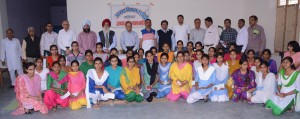
A group picture of all the girls in the school receivng support from IFCARE taken on the annual day function of the NGO. The adults standing in the back are the board members of IFCARE and some of the parents of the girls in the school.
The question I would ask is how did you feel? I imagine you felt very pleased with yourself and happy inside. Giving provides an opportunity to look beyond our own world and see the bigger picture. Your worries and challenges may not seem as significant when compared to other people’s situations.
The act of giving kindles self-esteem and brings happiness. After several years of soul searching, I discovered that my unhappiness was due to my want for things to fill the void of loneliness. During this inward journey, I also discovered “The Purpose of Living.â€Â Yes, I believe that giving makes you happier. But don’t take my word for it—try it out for yourself.
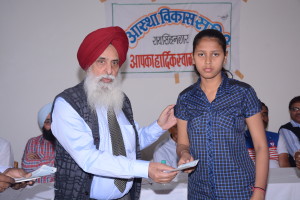
Dr. Gurmeet Singh, MD, President of Astha Vikas Samiti in Rajasthan, an NGO supported by IFCARE is handing over a chcke to Kum. Anjali Sain, a student in the local school.
The Power of Giving: Giving is one of the best investments you can make towards achieving genuine happiness. True giving comes from the heart, with no expectation of reciprocation. You’ll find that the more you give, the more you’ll receive. The power of giving is manifested in the kindness and generosity that you bestow on someone else. When you give unselfishly, the vibrational energy emitting from your subconscious is at its strongest. A famous American author, Ken Blanchard, declared “The more I give away, the more comes back.â€
It’s the joy and love that we extend to others that brings true happiness or union with God. We know that if people give just a little more—of their time, skills, knowledge, wisdom, compassion, wealth and love—the world would be a more peaceful and healthier place.
The rewards of giving are priceless. If you want to have happiness, you need to give happiness. If you want love, you need to give love. It is only in giving that you receive. No matter what your circumstances in life, you have the ability to give. The gift of joy will come to you when you give of yourself to others. Try it! Â It works!
Please join me in supporting the India Foundation (IF) for Children Education and Care (www.ifcare.org) to eliminate poverty in India through the education of underprivileged poor children and to empower poor women. Our Foundation awarded scholarships to 66 underprivileged poor children in Rajasthan, India on November 7, 2015 under its “SPONSOR A CHILD PROGRAM.†The sponsorship provides a needy child life’s essentials: school tuition, uniforms, books, school supplies, etc. for one year (100% of the donations go to the cause and are tax deductible in USA).
We are truly blessed and honored to serve humanity and poor children through our Foundation. We are truly grateful for compassion, kindness, and generosity of our sponsors to make a difference in the life of underprivileged poor children in India.
For further information, contact Darshan Goswami, 412-276-0544; dlgoswami@hotmail.com or Harbans Singh, 301-340-0836; or go to our website: (www.ifcare.org).  ♦
